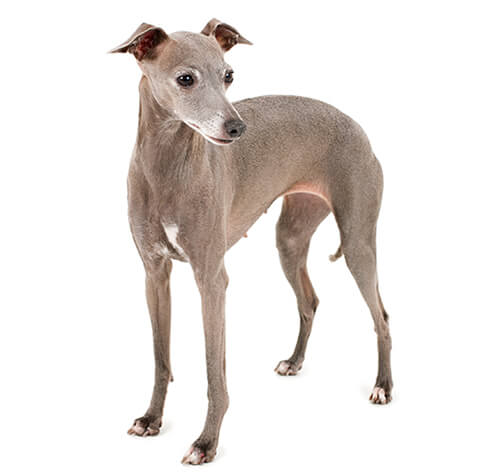
An ancient breed from the Mediterranean region, the Italian Greyhound excels as a companion and hunter of small game. Friendly with adults and children, this breed has a gentle, playful nature. An intelligent dog that is easy to train, the Italian Greyhound prefers spending time with his family. The smallest of the sighthounds, this active breed requires daily exercise. His smooth, glossy coat needs minimal grooming.
DID YOU KNOW? The Italian Greyhound was a favorite of royalty including: Anne of Denmark, Mary Beatrice d’Este of Modena, Frederick the Great of Prussia, Catherine the Great of Russia, and Queen Victoria.
ALSO KNOWN AS: Petit Levrier Italiane, Piccolo Levriero Italiano, Italienisches Windspiel
The need-to-know
- Dog suitable for owners with some experience
- Basic training required
- Enjoys active walks
- Enjoys walking half an hour a day
- Little toy dog
- Minimum drool
- Requires grooming once a week
- Non hypoallergenic breed
- Chatty and vocal dog
- Guard dog. Barks and alerts
- May require training to live with other pets
- May require training to live with kids
Personality

This is a clean, shy, gentle dog that loves to snuggle, partly out of affection and partly due to their need to keep warm! The Italian Greyhound does better with early socialisation so they will accept new people and situations more readily but they are nearly always a one-person dog. Once they have bonded to their owner, they will be inseparable and often are disinterested in other people or dogs.
History and Origins

Country of Origin: Italy
The Italian Greyhound is virtually a complete miniature of the full-sized Greyhounds – and originally was of great value as a high-status symbol in the poshest of households. Artists such as Van Eyck and Memling included these dogs in their paintings – and in Britain, they became highly fashionable in the Tudor and Stuart periods. Royalty fell under their spell and Charles 1, Queen Anne and Queen Victoria all owned Italian Greyhounds. Like many breeds however, the thing that made them popular became their downfall as the quest for smaller and smaller dogs led to serious health issues – and a dog that was far too delicate for anything but the most cossetted life. The breed was on the way to extinction before sanity prevailed and a group of breeders in the late Victorian era set about bringing the breed back to the unexpectedly hardy little dog they had previously been and that can now be seen today.
Nutrition and Feeding

Toy dogs have a fast metabolism, meaning they burn energy at a high rate, although their small stomachs mean that they must eat little and often. Small-breed foods are specifically designed with appropriate levels of key nutrients and smaller kibble sizes to suit smaller mouths. This also encourages chewing and improves digestion.
Exercise

Although a very small dog, this is still a sighthound and they do love to run. It is best to let the Italian Greyhound run in a confined space, though, as they can run off in pursuit of prey and are too small and easily injured to safely play with anything other than the gentlest of dogs. Exercise should be carefully monitored until the dog is fully grown - along with any stairs -and even then, care should be taken with their often-delicate limbs. A healthy adult should have at least an hour's daily exercise but they will also want to go everywhere with their owner.
Other Information

Health and Common Issues
The Italian Greyhound dog is generally a healthy breed but being so delicate, they can suffer from broken legs. As with many breeds, they can suffer from hereditary eye disorders and therefore eye testing prior to breeding is important.
Space Requirements
The Italian Greyhound can easily live in a small house as long as they have the chance to run safely. They prefer their homes to be warm as they do not tolerate the cold well at all.
Training Italian Greyhounds
An Italian Greyhound sees training as totally beneath them (although they are quite capable of learning the basics) but they should be taught to walk on a harness and a lead, and a good recall should be taught although not necessarily relied upon. Toilet training can be slow in the breed and they very often have separation related behaviour issues.
Best Family Dog Breeds
Italian Greyhounds generally do not make great family dogs as they are too delicate and sensitive for all but the quietest of families - and they generally bond exclusively to one person. While many dogs are traditionally thought of as being good with children, all dogs and children need to be taught to get on with and respect each other, and be safe together. Even so, dogs and young children should never be left alone together and adults should supervise all interactions between them.
Did You Know?
- Despite the name, the Italian Greyhound comes originally from ancient Egypt (where their mummified remains could be found entombed with pharaohs) as well as Greece and Rome.
- They are probably the very first breed to be developed purely as a companion and have been around between 4,000 – 7,000 years.
- Italian Greyhounds are known to chase cars, bikes, people and cats – they are a sighthound after all!